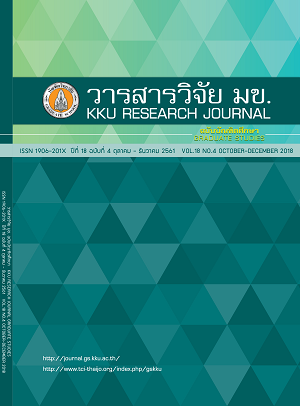Outcomes of Antimicrobial Discontinuation Following Guidelines in Patients with Hospital-acquired Pneumonia
Keywords:
Hospital-acquired pneumonia, Antimicrobial discontinuation guidelines, Recurrence rateAbstract
The objective of this study was to compare recurrence rates of hospital-acquired pneumonia (HAP) between the group discontinued antimicrobials within 48 hours after their clinical conditions met all the criteria in the antimicrobial discontinuation guidelines (study group) and the group of antimicrobials continuing (control group). Data of the patients admitted to Chiang Kham hospital, Phayao province between January 1, 2013 and June 30, 2016 were collected retrospectively. The clinical conditions in the antimicrobial discontinuation guidelines included 1) body temperature 2) oxygen saturation in peripheral blood 3) characteristics of sputum 4) signs and symptoms of pneumonia. From 181 HAP patients, there were 77 patients whom their clinical data were available for the evaluation according to the guidelines. Most of the patients had late onset HAP. The study demonstrated that recurrence rate of pneumonia was 5.1% (2 from 39 patients) in the study group and 7.9% (3 from 38 patients) in the control group. Due to limited number of patients in the study, the non-inferiority of recurrence rate between study and control groups could not be clearly concluded.
References
2. Werarak P, Kiratistin P, Thamlikitkul V. Hospital-acquired pneumonia and ventilator-associated pneumonia in adults at Siriraj Hospital: etiology, clinical outcomes, and impact of antimicrobial resisitance. J Med Assoc Thai. 2010;93 Suppl1:S126-138.
3. Guidelines for the management of adults with hospital-acquired, ventilator-associated, and healthcare-associated pneumonia. Am J Respir Crit Care Med. 2005;171(4):388-416.
4. Infectious disease association of Thailand. Thai clinical practice guidelines for management and prevention of adults with hospital-acquired and ventilator-associated pneumonia. [cited on 17 Jan 2014]. Available from: http://www.idthai.org/Guidelines/CPG%20For%20HAP-VAP%20Thai-05-Oct-2006.pdf
5. Pothirat C, Champunot R, Inchai J. The optimal duration of antibiotic treatment for hospital-acquired pneumonia: A comparative study between the two-antibiotic discontinuation policies [meeting abstact]. Chest. 2006;130 (4 Suppl):106S.
6. Micek ST, Ward S, Fraser VJ, Kollef MH. A randomized controlled trial of an antibiotic discontinuation policy for clinically suspected ventilator-associated pneumonia. Chest. 2004;125(5):1791-1799.
7. Hedrick TL, McElearney ST, Smith RL, Evans HL, Pruett TL, Sawyer RG. Duration of antibiotic therapy for ventilator-associated pneumonia caused by non-fermentative gram-negative bacilli. Surg Infect. 2007;8(6): 589-597.
8. Chastre J, Wolff M, Fagon JY, Chevret S, Thomas F, Wermert D, et al. Comparison of 8 vs 15 days of antibiotic therapy for ventilator-associated pneumonia in adults: a randomized trial. JAMA. 2003;290(19):2588-2598.
9. Dimopoulos G, Poulakou G, Pneumatikos IA, Armaganidis A, Kollef MH, Matthaiou DK. Short- vs long-duration antibiotic regimens for ventilator-associated pneumonia: a systematic review and meta-analysis. Chest. 2013;144(6):1759-1767.
10. Hospital-acquired pneumonia in adults: diagnosis, assessment of severity, initial antimicrobial therapy, and preventive strategies. A consensus statement, American Thoracic Society, November 1995. Am J Respir Crit Care Med. 1996;153(5):1711-1725.
11. Micek ST, Heuring TJ, Hollands JM, Shah RA, Kollef MH. Optimizing antibiotic treatment for ventilator-associated pneumonia. Pharmacotherapy. 2006;26(2):204-213.
12. Chastre J, Luyt CE. Optimising the duration of antibiotic therapy for ventilator-associated pneumonia. Eur Respir Rev. 2007;16(103):40-44.
13. Centres for disease control and prevention. CDC/NHSN surveillance definitions for specific types of infections. 2014 [cited on 11 Mar 2014]: Available from: http://www.cdc.gov/nhsn/pdfs/pscmanual/
14. Mandell AL, Anzueto A, Bartlett JG, Campbell GD, Dean NC, Dowell SF, et al. Infectious Diseases Society of America/American Thoracic Society consensus guidelines on the management of community-acquired pneumonia in Adults. Clin Infect Dis 2007; 44 Suppl 2: S27-S72.
15. Sealed Envelope Ltd. Power calculator for binary outcome non-inferiority trial [internet]. 2012 [cited 2018 Jul 20]. Available from: https://www.sealedenvelope.com/power/binary-noninferior/
16. Pugh RJ, Cooke RP, Dempsey G. Short course antibiotic therapy for gram-negative hospital-acquired pneumonia in the critically ill. J Hosp Infect. 2010;74(4):337-343.
17. Kalil AC, Metersky ML, Klompas M, Muscedere J, Sweeney DA, Palmer LB. et al. Management of adults with hospital-acquired and ventilator-associated pneumonia: 2016 Clinical practice guidelines by the Infectious Disease Society of America and the American Thoracic Society. Clin Infect Dis. 2016: 63(5):e61-e111.



